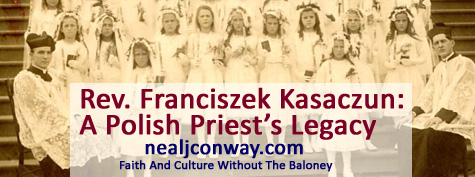 |
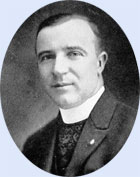 |
|---|
Rev. Franciszek Kasaczun: a Polish Priest's Legacy
April 1, 2011(Revised April 26, 2014)
| Page 1 | Page 2 | Page 3 | Page 4 |
|---|
The First World War (1914-1918) provided the opportunity for the realizationof the dream of Poland. While Germany and Russia promised the Poles independence if they fought, those two powers took the Poles' food to feed their armies. Even before the U.S. formally entered the war in 1917, the two most famous Poles in the world at the time were working up support among Americans, especially among Polish immigrants, for a properly fed Poland followed by an independent one.
Both activists were artists. One was the composer, Ignaz Jan Paderewski. He--a factoid from my grandmother's Polish almanac--once had all fingers so occupied during the playing of a piano piece that he had to strike a note with his nose. The other was Henryk Sienkiewicz, author of the early 1900s worldwide megabest-seller, Quo Vadis, a novel about the persecution of Christians by Emperor Nero. Quo Vadis was analogically about the Polish people under the thumb of oppressive rulers. Siekiewicz knew the power of literature and History.
President Woodrow Wilson promised that a new nation of Poland would be established after the hostilities ceased. Seven years into his three-decade pastorship of Holy Family, Father Kasaczun had become a well-known figure in the Wilkes-Barre area for his cheerleading of U.S. involvement in the European conflict.
It was an era of naive, over-the-top patriotism that ran to de facto and even de jure repression. Few understood that what Wilson had packaged as a moral crusade and fight for democracy was a mass slaughter, a slaughter which had actually begun as an accident of entangled alliances and which was continuing as a profiteers' business boom.
The Great War was a jet of gas across the ever-burning pilot light of anglo-saxon protestant America's suspicion of and disdain for foreigners. Now the church's mission of assimilating immigrants also included convincing the old-liners that the newcomers could be loyal, patriotic citizens willing to join the battle for America and its ideals. Fr. Kasaczun could boast in his public speeches that over 100 men from Holy Family were in uniform "over there" making "the world safe for democracy." He could remind his audiences that Casimir Pulaski and Thaddeus Kosciusko had helped America to win its independence.
The following shows how ignorant of the realities of the war the public was: among Polish patriots in the U.S. there was hope and expectation that the allied forces would march across Europe and fight to establish the new Republic of Poland. Of course Americans were being told that their doughboys could lick anyone, especially huns, but the truth was, they were stalemated in French and Belgian trenches.
As it happened the independent Poland, in which future pope Karol Wojtyla would be born in 1920, came to be without U.S. bloodshed. For a brief period, pianist Paderewski served as Prime Minister. However the major architect of the new Poland was Józef Klemens Piłsudski. Like the kings of old, Piłsudski fought off invaders (in 1920, the Soviets).
In the early years of that "second republic," young priest and future Auschwitz martyr Maximilian Maria Kolbe established a Franciscan monastery, a seminary, a publishing house and what was probably the first Catholic radio station. Maria Faustina Kowalski persevered in becoming a nun and was granted the now-familiar vision of Jesus' Divine Mercy.
All throughout the 1920s, Father Kasaczun continued his patriotic efforts on behalf of The Second Polish Republic. He was personally aquainted with Paderewski and Sienkiewiecz who travelled through Northeastern PA making public appearances. He also knew Josef Haller, the social-worker general who had thrown out the Germans in 1918 and fought with Piłsudski to keep Soviet communist forces from attacking Europe.
For the twenty-fifth anniversary of Holy Family Parish in 1928, Kasaczun oversaw the publication of a remarkable book. Composed in English in some parts and in Polish in others, it included chapters not only about the parish, its people, Northeastern PA, but also chapters about Polish history, literature and the current Rzeczpospolita.
For his work, the Republic of Poland awarded the small-town priest its highest honor, the Order of Polonia Restituta ("Poland Restored"). One can only imagine how depressed Fr. Kasazcun and other Polish patriots must have felt when, in September of 1939, Poland was overrun once more by Germany.
In failing health, the 55-year-old pastor took a vacation to Cuba and in January of 1942, he died there of a brain hemorrhage. News of his passing was conveyed to the congregation by the slow, heavy tolling of Holy Family's church bell.
Later that year, in Nazi-occupied and terrorized Krakow, a young man knocked on a door with a hand that had been roughened and wrinkled by labor in a quarry and a chemical plant. The door was that of Krakow's archbishop, Cardinal Adam Sapieha, a man whose last name is found throughout Polish/Lithuanian history. The young man was Karol Wojtyla, student of Polish letters, poet, dramatist, actor, come to request that he be admitted to the seminary. Continue to Page 4.
| Page 1 | Page 2 | Page 3 | Page 4 |
|---|
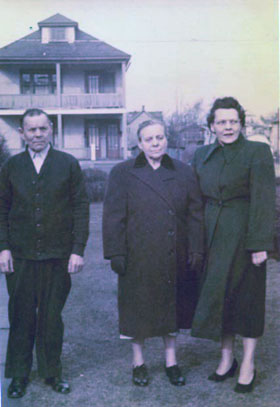 |
|---|
| Above: Circa 1950 in Ashley, PA, my grandmother Boleslawa "Bertha" Tombak Bradshaw (right) with her parents Paul Tombak and Josephina Woroneski Tombak. Paul immigrated first and remitted money for Josephina and Boleslawa to follow in 1908.
In the U.S., the couple had two more daughters. As Boleslawa was, the daughters, Sophia and Jadwiga (Hedwig), were baptized with the names of figures in Polish history. Relatives that I am in contact with and I know very little about our Polish ancestors. Josephine Woroneski's mother's name was Rosalie Tevitz. The Tombak name occurs not only in Poland but also in Lithuania, Estonia and Russia. It's possible that Tombaks in remote history migrated from the Middle East for Tombak is a Persian word for a goblet-shaped drum. My great aunts corresponded with and sent money to Polish relatives after World War II, however the contact was discontinued when the Polish relatives expressed dissatisfaction with the amounts of money that they were receiving. After the Nazis' 1939 invasion, male family members fought with the Polish military, including the air force, in exile in Britain. When the Soviet Communists took over Poland after the war, they did not want experienced and disillusioned freedom warriors returning and they arrested any who came back. Thus the relatives settled in England and Australia.
Below are photos of unidentified Polish relatives. The young lady in the hand-colored portrait is believed to be my great-grandmother Woroneski's sister's daughter. The group with the village shown in the background could be in either Poland, England or Australia and are likely to be Woroneskis.
|
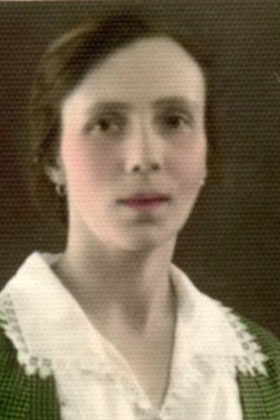 |
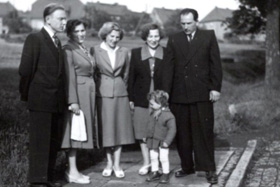 |
Copyright 2011 by Neal J. Conway. All rights reserved.
About this site and Neal J. Conway
Make homepage nealjconway.com appear in this window